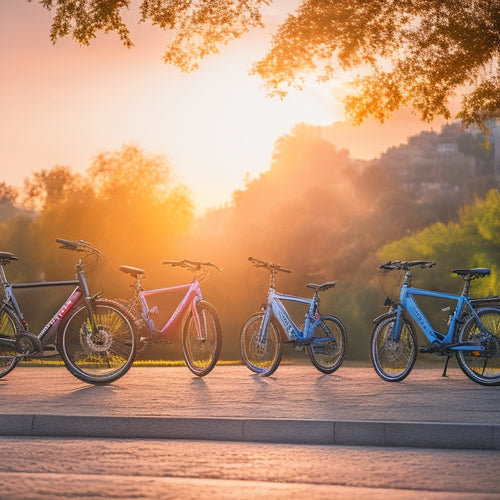Why DIY Solar Panel Installation Costs More
Share
You might think DIY solar panel installation is a cost-effective option, but it can ultimately end up costing you more. You're taking on higher risk factors like equipment damage, electrical shock, and physical harm. Improper installation reduces efficiency, and you might end up with an incorrectly sized system that wastes money and energy. Inadequate wiring, insufficient roof preparation, and lack of warranty protection can also increase costs. And, despite DIY efforts, you'll still need to pay for professional labor, specialized tools, and utility interconnection fees. As you explore solar panel installation, you'll discover more factors that can drive up costs.
Key Takeaways
• DIY solar panel installation increases risk factors, including damage to equipment or roof, costly repairs, electrical shock risks, and physical harm risks.
• Incorrect system sizing can lead to wasted money, energy, and resources, as well as reduced energy efficiency and increased energy costs.
• Inadequate wiring and connectors can cause energy output reduction, malfunctions, and safety risks, including electrical shock and fire hazards.
• Insufficient roof preparation can lead to water damage, structural weaknesses, and compromised system performance, ultimately adding to the overall cost.
• Lack of warranty protection and professional labor costs can result in significant financial losses, liability for damages, and costly repairs or replacements.
Higher Risk of Damage
When you attempt to install solar panels on your own, you're more likely to damage the equipment, the roof, or both, which can lead to costly repairs or even render the system inoperable. Without proper training and experience, you're exposing yourself to potential risks, including electrical shock and physical harm.
Electrical shock can occur when you don't follow proper safety protocols, such as turning off the main power supply before starting the installation. Physical harm can result from lifting heavy equipment, climbing ladders, or working at heights without proper safety gear. Additionally, improper installation can lead to system malfunctions, reducing the overall efficiency and lifespan of your solar panels.
Incorrect System Sizing
When you're installing solar panels, getting the system size just right is essential. If you don't, you'll either waste money on an oversized system or struggle with an undersized one that can't meet your power needs.
Oversized Systems Waste Money
Incorrectly sizing your solar panel system can result in wasted money, as oversized systems produce more energy than you can use or store. This energy inefficiency leads to unnecessary costs, as you'll be paying for more power than you need. An oversized system also leads to system redundancy, where you're paying for equipment that's not being utilized to its full potential.
When you install an oversized system, you'll be generating more electricity than you can consume or store. This excess energy is wasted, and you won't be able to take advantage of it. Additionally, oversized systems require more components, which increases the upfront cost. You'll be paying for additional panels, inverters, and mounting hardware that you don't need.
Undersized Systems Lack Power
If you underestimate your solar panel system, you'll likely find yourself struggling to meet your energy needs, as an inadequately sized system can't generate enough electricity to power your home or business. This oversight can lead to reduced energy efficiency, as your system won't be able to harness the full potential of the sun's energy.
You'll be left relying on the grid for supplemental power, increasing your energy costs and negating the benefits of going solar.
To avoid this, it's essential to accurately assess your energy requirements and design a system that meets your specific needs. A system with adequate capacity will make sure you're generating enough power to meet your energy demands, reducing your reliance on the grid and maximizing your energy savings.
Miscalculations Cost You
You'll be left with a system that's inefficient and costly if you don't accurately calculate your energy needs and size your solar panel system accordingly. Measurement mistakes and calculation errors can lead to a system that underperforms, resulting in higher energy bills and a lower return on investment.
Here are some common miscalculations to avoid:
-
Incorrect roof size measurements: Failing to account for obstacles like skylights, vents, and chimneys can lead to inaccurate system sizing.
-
Inaccurate energy usage estimates: Underestimating your energy needs can result in a system that can't meet your power demands.
-
Oversized systems: Installing a system that's too large for your energy needs can lead to wasted resources and higher upfront costs.
-
Ignoring local building codes and regulations: Failing to comply with local regulations can result in costly rework or even system removal.
-
Insufficient battery sizing: Undersizing your battery bank can lead to reduced system performance and a shorter lifespan.
Inadequate Wiring and Connectors
Inadequate wiring and connectors can lead to a significant reduction in your solar panel system's energy output, as they create electrical resistance that decreases the flow of current. This can result in a system that's less efficient and produces less power. Moreover, inadequate wiring and connectors pose serious safety risks, including corrosion risks and electrical shock.
| Inadequate Wiring/Connectors | Consequences |
|---|---|
| Corroded connectors | Reduced energy output, electrical shock risks |
| Insufficient wire sizing | Overheating, electrical shock risks |
| Incorrect wire connections | Electrical shock risks, system malfunction |
| Poorly secured wires | Physical damage, electrical shock risks |
| Inadequate grounding | Electrical shock risks, system malfunction |
Insufficient Roof Preparation
Failing to properly prepare your roof before installing solar panels can lead to a multitude of issues, including water damage, structural weaknesses, and compromised system performance. As a DIY installer, you might overlook essential steps, compromising the integrity of your roof and the entire solar panel system.
Here are some common oversights to avoid:
-
Inadequate roof inspection: Failing to identify and address existing roof damage, such as cracks, holes, or worn-out shingles, can lead to leaks and water damage.
-
Insufficient weatherproofing measures: Neglecting to apply necessary weatherproofing materials and techniques can compromise the structural integrity of your roof.
-
Poorly secured mounting systems: Improperly secured solar panels can shift or fall, causing damage to your roof and the panels themselves.
-
Inadequate flashing installation: Failure to install flashing correctly can lead to water seepage and damage to your roof and walls.
-
Incompatible roofing materials: Using incompatible materials can compromise the structural integrity of your roof and the solar panel system.
Lack of Warranty Protection
When you install solar panels yourself, you risk compromising your warranty protection. You'll need to contemplate the potential consequences of voiding manufacturer warranties, having limited system warranty coverage, and receiving no system support.
Voiding Manufacturer Warranties
By installing solar panels yourself, you risk voiding the manufacturer's warranty, which can leave you with costly repairs or replacements down the line. This can lead to significant financial losses, especially if you're dealing with a large-scale solar panel system.
Warranty regulations are in place to protect consumers, but they can also be voided if the installation isn't done according to the manufacturer's specifications. As the installer, you take on the liability for any damages or defects that may arise from improper installation.
Here are some key points to take into account:
-
Warranty voidance liability falls on the installer, which can be you.
-
Improper installation can lead to system failures, reducing the overall efficiency of your solar panel system.
-
Manufacturers may refuse to honor warranties if they deem the installation wasn't done correctly.
-
DIY installations can lead to safety hazards, such as electrical shock or fire risks.
-
You may be left with the full cost of repairs or replacements, which can be costly.
Limited System Warranty
You may also compromise your warranty protection by installing solar panels yourself, as most manufacturers only provide a limited system warranty that covers defects in materials and workmanship for a specified period, usually 10 to 25 years. This limited warranty duration can leave you exposed to costly repairs or replacements if issues arise outside of the warranty period. A professional installation, on the other hand, often includes a more thorough warranty that covers the entire system, including labor and materials, for a longer period.
When you install solar panels yourself, you may not be aware of the warranty terms and conditions, which can lead to unexpected expenses. A Warranty Comparison between DIY and professional installations reveals that professional installers often provide a longer warranty duration, sometimes up to 30 years or more. This extended warranty protection can give you peace of mind and protect your investment in the long run.
No System Support
Without professional installation, you're left to troubleshoot and repair system issues on your own, sacrificing the technical support and warranty protection that comes with a professionally installed solar panel system. This lack of guidance can lead to technical difficulties, which can be frustrating and time-consuming to resolve.
Here are some potential consequences of DIY solar panel installation:
-
Increased downtime: Without technical support, you may struggle to identify and fix issues, leading to extended periods of system downtime and lost energy production.
-
Reduced system performance: Without expert guidance, you may not optimize your system's performance, resulting in reduced energy output and savings.
-
Safety risks: Without proper training and experience, you may inadvertently create safety hazards, such as electrical shock or fire risks.
-
Voided manufacturer warranties: Failing to follow manufacturer guidelines can void your warranties, leaving you with costly repairs or replacements.
-
Long-term costs: Lack of technical support can lead to premature system degradation, resulting in higher maintenance and replacement costs in the long run.
Professional Labor Costs Still Apply
Even with a DIY solar panel installation, professional labor costs still apply for certain aspects of the project, such as electrical connections and inspections. You may think you're saving money by doing it yourself, but you'll still need to hire a licensed electrician to guarantee the system is installed safely and meets local building codes.
| Labor Component | Cost Range | Why It's Necessary |
|---|---|---|
| Electrical connections | $500-$1,000 | Ensure safe and code-compliant connections |
| Inspections and permits | $300-$800 | Verify compliance with local building codes |
| Union fees | $200-$500 | Pay for labor union representation (if applicable) |
| Workforce scarcity premium | $500-$1,000 | Account for labor shortages in your area |
You may be able to do some of the installation yourself, but these critical components require specialized expertise. Don't underestimate the costs of professional labor - it's crucial to guarantee your solar panel system is installed correctly and safely.
Specialized Tools and Equipment
Installing a solar panel system requires access to specialized tools and equipment, such as wire strippers, crimpers, and multimeters, which can add significant costs to your overall project expense. As a DIY enthusiast, you'll need to invest in these tools or explore rental options, which can be costly.
Here are some of the key tools and equipment you'll need:
- Wire strippers: for stripping insulation from electrical wires
- Crimpers: for crimping wire connectors and terminals
- Multimeters: for measuring voltage, current, and resistance
- Ladders and scaffolding: for safely accessing rooftops and installing panels
- Thermal imaging cameras: for detecting heat anomalies in your system
These specialized tools and equipment can be expensive to purchase or rent, and their maintenance can be costly in the long run. Additionally, if you're not familiar with their proper use, you may end up damaging your system or compromising your safety.
As you weigh the costs and benefits of DIY solar panel installation, consider the expenses associated with acquiring and maintaining these specialized tools and equipment.
Utility Interconnection Delays
You'll likely encounter utility interconnection delays, which can add weeks or even months to your project timeline, as the utility company verifies that your solar panel system meets their grid connection requirements. This delay can be frustrating, especially if you're keen to start generating your own clean energy.
| Delay Cause | Impact |
|---|---|
| Permitting Backlogs | Slows down project timeline |
| Grid Capacity Issues | Requires additional infrastructure upgrades |
| Utility Company Workload | Increases wait time for connection approval |
| Incomplete Application Submissions | Rejected applications, further delaying connection |
These delays can be attributed to various factors, including permitting backlogs, grid capacity issues, and utility company workload. In some cases, incomplete application submissions can also lead to rejections, further delaying connection. To mitigate these delays, it's crucial to make sure that your application is complete and accurate, and to plan for potential setbacks in your project timeline. By understanding the causes of utility interconnection delays, you can better prepare for the unexpected and minimize their impact on your DIY solar panel installation project.
Frequently Asked Questions
Can I Install Solar Panels on a Metal or Clay Tile Roof?
When installing solar panels on a metal or clay tile roof, you'll need to guarantee proper Roof Preparation to prevent Tile Damage, utilizing suitable Waterproofing Methods that cater to your specific Roof Material, ensuring Solar Compatibility and a secure installation.
Do I Need a Building Permit for a DIY Solar Panel Installation?
You'll likely need a building permit for your DIY solar panel installation, as local ordinances regulate electrical and structural integrity; factor in permit fees, which vary by jurisdiction, to guarantee compliance.
Can I Mix Old and New Solar Panels in My DIY Installation?
When mixing old and new solar panels, you'll encounter panel compatibility issues, potentially resulting in efficiency loss, so make sure compatible voltage, current, and connector types to minimize power losses and optimize your DIY installation's overall performance.
Will My Homeowner's Insurance Cover DIY Solar Panel Installations?
Like a puzzle piece not fitting, your DIY solar panel installation might not align with your homeowner's insurance policy, leaving you with insurance gaps and policy exclusions that can leave you financially exposed in case of damage or loss.
Can I Install Solar Panels on a Roof With Multiple Skylights?
You'll need to assess your roof's suitability for solar panels, considering skylight obstructions and ideal roof angles, ensuring sufficient space for panel placement and unobstructed sunlight exposure to maximize energy harvesting.
Related Posts
-

Find Your Eco-Friendly Motorcycle for a Sustainable Ride
You're shifting gears towards a more sustainable ride, opting for an eco-friendly motorcycle that combines thrill wit...
-

Sustainable Commuting: Top Daily Use Electric Bicycles
You're looking to trade in your gas-guzzling vehicle for a more sustainable option, and a daily use electric bicycle ...
-

5 Best Practices for Long-Lasting Sustainable Batteries
To maximize the lifespan of your batteries, you should optimize charging cycles by maintaining a charge level between...


